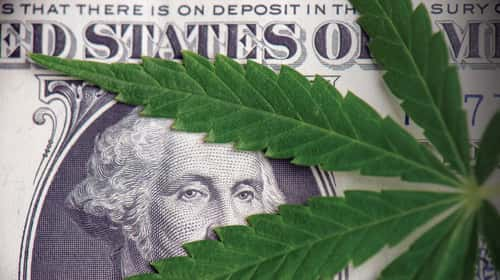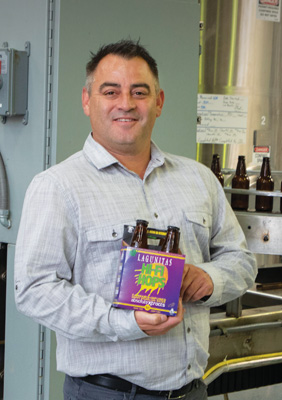

Calaveras County Sheriff’s marijuana enforcement team checked their equipment, tightening up vests, and inspected their guns as they geared up for yet another raid on an unlicensed cannabis grow. The deputies stormed a West Point, Calif., residence February 13, seizing 440 pounds of marijuana, along with 1,400 plants being cultivated in an outbuilding with dangerous wiring. The illegal haul was worth $2.4 million.
The greenhouse grow is an example of the thriving cannabis black market in California. Only 20 percent of the cannabis grown in California is sold through legal dispensaries. Legal cannabis businesses produced revenues of $3.1 billion last year, while their black-market cousins pushed out $8.7 billion, according to BDS Analytics, which provides data on the cannabis industry.
When California passed Prop 64 making recreational cannabis legal in 2016, it was hailed as a win-win at the ballot box. Law enforcement would devote resources to protect and serve in other ways, not having to worry about hunting down grow houses like the one in West Point. Consumers could legally buy the pot they were buying anyway. Players who grew and sold cannabis could come out of the shadows and open new businesses, providing thousands of jobs. And state and local governments were going to have access to wads of new tax revenues.
The state gave itself 14 months to put a system in place that would allow for all the above to take place. Turns out it wasn’t enough time.
Last October, Santa Rosa’s CannaCraft Inc. let 16 percent of its workforce go. Flow Kana Inc., a huge processor and distributor based in Mendocino, put 20 percent of its staff on the street last year. Weedmaps, the Southern California company that operates a somewhat notorious online guide to dispensaries, reduced its headcount by 25 percent.
MedMen Enterprises, a Los Angeles-based chain of retail outlets that were compared favorably to Apple stores for their clean look, dumped 190 staffers in September of last year. Eaze Inc., a San Francisco delivery service streeted 20 percent of its crew last year as well. And Southern California’s KushCo Holdings made an adjustment to its payroll this March, sending 50 percent of its employees to seek other work.
These kinds of cuts are indicative of a legal industry under fire. “It’s like we are being punished for doing the right thing, and getting our license and paying taxes,” says Dennis Hunter, the founder of CannaCraft. His company is well known in cannabis circles for its brands, Care By Design, Satori and AbsoluteXtracts of CBD, edibles and extracts.

Hunter views the struggle from a unique perch. He has been awarded the “100 Most Influential People in Cannabis” by High Times every year that the media company and industry pillar has given the award, along with fellow well-known cannabis figures like Cheech and Chong, Snoop Dogg, and political advocates like Cory Booker. He is a respected voice and has lived life on both sides of cannabis law. He has been in the industry since the ’80s and has achieved success in both the legal and illicit cannabis market. Hunter grew up in pot country and became a master grower long before cannabis was legal. He has pursued cannabis because of his belief that it should be legalized, and is a healthier treatment for specific illness and recreational use when compared to certain prescription drugs and alcohol, which statistically have been shown as detrimental to public health. He made a nice living growing and wholesaling marijuana, but eventually he was caught when federal agents discovered his cultivation site in Humboldt County, which at the time was the largest cannabis grow in California’s history. He spent a little over six years in federal prison.
Today, Hunter employs 200 people and takes meetings with state officials trying to reshape a state cannabis program that clearly isn’t working for anybody. He says that the combination of licensing fees, product taxes and local taxes puts legitimate businesses in the unfair position of competing against a black market that doesn’t pay taxes at all. “You have cultivation taxes, excise taxes and local taxes,” he says, listing regulatory costs like the CEO of General Motors. “Governments looked at cannabis as a way of building revenues. And if you are in the black market, you look at taxes as a big reason to keep doing things the way you are.”
Hunter certainly isn’t the only one in the cannabis sector pointing out the playing field isn’t just uneven, it tilts significantly towards the illicit market.
Mikey Stenimetz is the CEO of Flow Kana and was featured on CBS’s 60 Minutes last year, trying to explain why the legal cannabis market was struggling. The Mendocino-based company works with growers to distribute and process legally grown weed throughout the state. And he has some definite ideas on what has gone wrong. “Since 2018, California cannabis taxes have generated more than $1 billion in revenue for the state. Over 39,000 jobs exist in California’s legal cannabis industry today. An estimated $1 billion is spent on cannabis monthly in California, but only $1 in $4 dollars is being spent in the regulated market. The rest is spent on the illicit side. California produces 80 percent of all the cannabis consumed in the United States. None of that is legal outside of the state borders—so where is it all coming from? Our illegal market.”
The numbers don’t lie. Legal products offered in California sell for more than what is offered on the black market, by as much as 45 percent because of fees and taxes. That pricing structure greatly reduces the margins available to legal businesses, so much so there are times when legal businesses will sell into the black market just to improve their balance sheets.
It’s hard to open a copy of the Wall Street Journal without reading about a corporate captain bemoaning the burden of regulation and the hard costs associated with jumping through hoops and compliance. And while no one mistakes the California cannabis industry for corporate America, the basics of toiling for profit and delivering a better product has much in common whether you’re selling Chevys in a showroom or flower in a dispensary.
A backwards look
Long known for producing the best cannabis in the world, the heart of the Golden State’s marijuana industry is still found in the Emerald Triangle, which consists of Mendocino, Trinity and Humboldt counties. While the counties are rural and rugged, they also have some of the best soil and sun for growing marijuana, with combined lands about the size of Massachusetts. Since the ’60s, the Triangle was home to an illicit industry that was an open secret to locals. It created a new culture built on hillside grows that gave a whole new meaning to the phrase “cash crop.” Growers did errands in brand new pickups and settled their bills at the hardware store with greenbacks while playing a dangerous cat-and-mouse game with state and federal law enforcement. The marijuana flowed out of the Triangle to other parts of California to be sure, but those growers soon became the chief source of pot for a nation split over the idea of getting high versus calling the cops on those “dope smoking hippies.”
Cannabis became legal for the first time in 1996 when California voters approved making medical pot available to patients who had been approved by doctors. While the victory at the ballot box was celebrated by patients seeking alternative medicine, and by Californians seeking to soften the criminal pursuit of marijuana users, the reality of the situation was different.
The regulatory system for medical marijuana in California turned out to be a bureaucratic nightmare for patients, doctors, lawmakers, law enforcement and growers. The system was riddled with inconsistencies, hard to navigate and complicated enough to keep the black market thriving even as growers and sellers had a chance to come out of the shadows. The system earned the unusual achievement of actually having its users begging for more regulation, or at least regulation that would work better.
But even as the medical pot system limped along, those in the industry frequently told each other that one day cannabis would be legal in California, and that liberation would provide an easy and legitimate way for cannabis users to access the drug they were now getting through a Byzantine system.
The state’s cannabis regulatory regime for adult use pot consisted of the Bureau of Cannabis Control, CalCannabis and Manufactured Cannabis Safety Branch. If the state was shooting for streamlined and easy to use, it missed and ended up with clunky and confusing. And once again those using the system asked the state for regulations that might help, rather than hinder the process of opening legal cannabis businesses.
One troubling part of the process is that the state elected to allow county and other local governments to set their own regulatory requirements and fee systems, which means that cannabis businesses in Napa face a different set of rules than those in Sausalito. Along with different standards came different fee structures which helped push the cost at legal outlets higher by about 45 percent from the black market as the fees are passed to consumers. The difference in pricing levels, of course, makes black market marijuana more attractive.
Unintended consequences
Allowing each local government body to decide how to handle cannabis gives the government the opportunity to not handle marijuana. According to Frontier Data, a cannabis data service, just 33 percent of the state’s cities allow any cannabis business. Counties aren’t much better, with only 41 percent having cannabis business operations. When it comes to cultivation, only 10 of 58 counties have licensed businesses that contribute in a meaningful way to the legal market, with Santa Barbara and Humboldt county growers holding 57 percent of the grow licenses.
The lack of retail operations creates a “desert” in which consumers can’t purchase products legally from local merchants, a condition that makes black market product more attractive if only because its more accessible.

While a lack of cannabis outlets makes it harder on consumers, and benefits the illicit market, Matthew Bartlett, a senior operating partner with cannabis investment firm Merida Capital Partners, thinks this problem is beginning to ease. “A shortage of brick-and-mortar retail stores has been an issue and the black market already has its distribution system in place,” says the Healdsburg resident. “But technology is changing. There are now apps and delivery services that can bring cannabis right to your door, something that became more important with COVID-19.”
Bartlett, who used to run the wine industry lending division for Bank of Marin, has operated two different cannabis businesses in the North Bay and sits on the board of directors of Santa Rosa-based cannabis company GABY. He believes the impact of the black market will lessen as consumers realize that illicit cannabis is not tested, so growers can use any pesticides they want in growing the product. “The variety of products as well as the quality of those products on the legal side is far superior to what people find on the illicit side,” he says.
While a lack of retail access has challenged the legal cannabis industry, a different retail problem has cropped up in Los Angeles and other parts of the state. Weedmaps has included the locations and even ratings for illicit retail locations right alongside legal dispensaries. The listings and recommendations placed the illegal shops on an equal footing in terms of exposure to potential customers. It also put Weedmap in the crosshairs of state regulators.
At first, Weedmap put the state off, saying as an online search business, they were regulated in the same way as Yahoo and Google. But the company was hit with a subpoena from a federal grand jury earlier this year and the subpoena named more than 100 cannabis businesses, employees as well as investors. Now Weedmap says its weeding out (no pun intended) illegal players as its owner Ghost Management Group navigates its new legal landscape.
The Weedmap subpoena also shows that while the federal government has pretty much left the state alone in terms of cannabis, the grand jury should give pause to both state regulators and cannabis businesses that federal intervention may be an emerging agenda, especially with the newly suspect Justice Department leadership and political agenda of Attorney General William Barr.
The Weedmap issue aside, state and local law enforcement no longer count illegal cannabis among its priorities. So black market operators know they don’t have much risk in doing business, and they enjoy a better margin than their legal brethren.
What’s ironic is that more agencies than ever are involved in black market cannabis enforcement, but they are all acting independently. The Bureau of Cannabis Control, the California Highway Patrol, the state Fish and Game Agency, the Campaign Against Marijuana Production and even the National Guard have seized plants and pot this year.
Want another helping of irony? The Bureau of Cannabis Control has made a request for the next state budget to add 87 law enforcement positions. According to media reports, 58 of the new BCC employees would come from transfers from the Department of Consumer Affairs Cannabis Enforcement Unit. The remaining 29 would be sworn law enforcement officers.
The word sworn may sound clunky, but it’s important because many investigators on staff are not sworn officers, so they can’t do some important work like access criminal databases, make arrests, or write search warrants.
And the Bureau has a backlog of probes because it is already understaffed, according to a state audit last year. The agency has more than 100 vacant positions, which doesn’t count the newly requested cops.
The future
Bartlett says that traditional enforcement against illicit cannabis businesses have not worked, so the state needs to move in a fresh direction. He believes the most productive way to aid the California cannabis sector is for the state to form a transition board to help those in the black market to go legit.
“There needs to be a pathway with assistance to go legal, help with the paperwork and in understanding the regulations,” Bartlett says. “I think that is part of the problem, along with reducing taxes so it is more attractive to those trying to transition as well as those already in the business but struggling. Cannabis and California are nearly synonymous, however, we fall way behind most of the nation in progressive tax initiative and creating clear paths for business.”
Hunter echoes Bartlett’s view that the traditional carrot and stick isn’t working, and in a past life Hunter felt the stick. “People don’t understand all of the cost involved in putting people in prison and keeping them in prison. We need to look at ways to make being legal a better choice.”
Bartlett thinks educating consumers to buy in the legal market is a significant way for the sector to chip away at the illicit market’s effectiveness. “California has grown some of the best cannabis in the world for a long time now, everybody understands that. But consumers need to know that the quality and the safety of the products in legal dispensaries is much better than those found in the black market, which does no testing and uses whatever pesticides it wants on their plants.”
The battle between legal and black market cannabis has one other angle, how investors look at California’s cannabis market. Bartlett says his firm focuses on the management of companies they are considering investing in, their ability to differentiate the market, as well as the availability of operating licenses. So California scores high, sort of. “California has seasoned operators and decades of knowledge, but there are lots of licenses to be had.”
And the reality is that Bartlett knows California as well as any investor looking to put cash to work, so his take is that although the Golden State has been difficult for both operators and investors over the past few years, opportunities are beginning to look more appealing.
But not so long ago I was in Los Angeles at a cannabis conference, talking to investors and operators. I was having a beer with the CEO of a Midwestern cannabis company that was weeks away from going public, and he was telling me of his plans for expansion into different states. California didn’t come up, so I asked him why his company had no desire to make a move in the world’s largest cannabis market?
He shook his head and smiled. When the market gets fixed he said, that’s when his company would start writing checks.
By Bill Meagher

